#lama tsongkhapa
Explore tagged Tumblr posts
Text
LAMA TSONGKHAPA DAY!!!!!!!
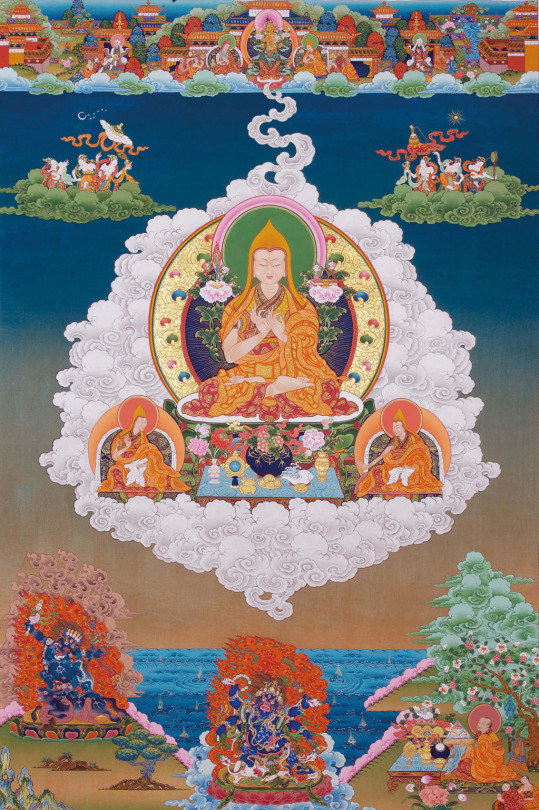
༈ དམིགས་མེད་བརྩེ་བའི་གཏེར་ཆེན་སྤྱན་རས་གཟིགས། ། དྲི་མེད་མཁྱེན་པའི་དབང་པོ་འཇམ་དཔལ་དབྱངས། ། བདུད་དཔུང་མ་ལུས་འཇོམས་མཛད་གསང་བའི་བདག ། གངས་ཅན་མཁས་པའི་གཙུག་རྒྱན་ཙོང་ཁ་པ། ། བློ་བཟང་གྲགས་པའི་ཞབས་ལ་གསོལ་བ་འདེབས། །
mikmé tsewé terchen chenrézik drimé khyenpé wangpo jampal yang düpung malü jomdzé sangwé dak khangchen khépé tsukgyen tsongkhapa lobzang drakpé shyapla solwa dep
Great treasury of non-referential compassion, Avalokiteshvara, Powerful lord of flawless wisdom, Manjushri, And destroyer of all the hosts of mara, Vajrapani, Lord of Secrets— Crowning glory amongst all the learned masters of the Land of Snows, Tsongkhapa Lobzang Drakpa, at your feet I pray!
(Tibetan text, romanization and translation from Rigpa Wiki.)
May the wisdom and vast, systematic knowledge of Buddhist scripture attained by the great guru Je Tsongkhapa, and transmitted to us by his disciples in the gelug tradition, guide us in this upcoming year. May the teachings remain in this world and benefit all sentient beings until we attain the complete cessation of suffering.
#buddhism#buddhadharma#dharma#tsongkhapa#losang dragpa#gelug#gelug buddhism#gelugpa#tibetan buddhism#lama tsongkhapa
22 notes
·
View notes
Text

"[Tsongkhapa] (...) refers to the first meeting between Milarepa and Gampopa, in which Milarepa asked about Gampopa's meditation. Gampopa replied that he could sit in meditative absorption for many days at a time without distraction. Milarepa told him, "You cannot get oil by crushing sand. The practice of samadhi is not sufficient in and of itself.
You should learn my system of inner heat yoga...." The implication is that the innate ecstasy conjoined with wisdom awareness, which is aroused by the inner heat yoga, was absent, and thus Gampopa's samadhi lacked real tantric power. Arousing that "real tantric power" is the purpose and territory of the inner heat doctrine. (...)"
Lama Glenn Mullin
("The Six Yogas of Naropa" -Tsongkhapa's
Commentary
By Tsong-kha-pa
#buddha#buddhist#buddhism#dharma#sangha#mahayana#zen#milarepa#tibetan buddhism#thich nhat hanh#enlightenment spiritualawakening reincarnation tibetan siddhi yoga naga buddha
17 notes
·
View notes
Text

"True illuminates have no dreams. Dreams are for those who are asleep. True illuminates live in the higher worlds, out of the physical body, in a state of intensified wakefulness without ever dreaming." - Samael Aun Weor
Dream Yoga
The effort to awaken the consciousness in the dream state is called Dream Yoga. This term is most known from the tradition of Tilopa, Naropa, Marpa, and Milarepa, although the tradition of Niguma also includes Dream Yoga. Yoga comes from the Sanskrit word "yug," which means to "reunite" or "yoke together." This is the same as the root of our word religion, the Latin word "religare,"which means "to bind together." What is sought in both cases is the union of our consciousness with its source, but this can only happen when our consciousness is awakened and purified of all that is unclean.
The yogic tradition of Tilopa has been maintained in Tibetan Buddhism for hundreds of years. It is a series of teachings of which dream yoga is a vital part. It has been practiced and taught by all the Dalai Lamas, and such great initiates as Tsongkhapa and Milarepa.
The basic goal of Dream Yoga is to harness the power of the dream state and use it to awaken the consciousness. You can learn more about this by reading scriptures from the tradition.
27 notes
·
View notes
Text
i did not realise until reading this propagandum from the tibetan government that the infamous Rdorjeshugsidan/Dorje Shugden/Dolgyal/Gyalchen Shugden is an apotheosised version of the 17th century Gelug lama Tulku Drakpa Gyaltsen, who was a student of the Gelugpa founder Je "Leekvale" Tsongkhapa, Drakpa being a rival of the Dalai Lama at the time, who lost the power struggle so much that his incarnation lineage was suppressed. This suppression is presumably turned into repression, and his propitiation in Sith form.
explains a lot rly
6 notes
·
View notes
Text
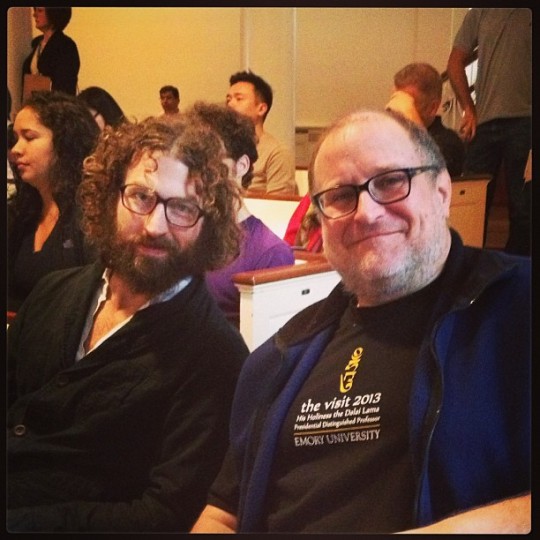
I thought I had lost this photo forever when my previous Facebook account disappeared, but I found it in my Gmail where I had emailed a friend about the event. The photo is my friend John Moulton and I at the teaching event by His Holiness the Dalai Lama at Emory University in October 2013. The teaching was primarily in Tibetan, with an English translator, and it focused on the root text of the Mahamudra by the 1st Panchen Lama, Losang Choekyi Gyaltsen (1570–1662). This was my introduction to that text, although I had studied Buddhism for many years, including Buddhist psychology in grad school. My grad school studies focused on the Buddhist philosopher Tsongkhapa (1357–1419).
Earlier in October 2013, during the same visit to Emory, His Holiness spoke to a packed auditorium at Gwinnett Center on “The Pillars of Responsible Citizenship in the 21st Century Global Village.” I got to attend that event with several friends.
5 notes
·
View notes
Text
Unsere erste Besichtigung das Drepung Monastery. Drepung ist eines der bedeutendsten Klöster der Gelug-Schule und war eines der drei großen so genannten „Staatsklöster“ des früheren Tibet, nicht ganz 10 km westlich von Lhasa gelegen. Drepung wurde 1416 von Jamyang Chöje Trashi Palden – einem Schüler des Tsongkhapa, des Begründers des Gelug-Ordens – gegründet. Es zählt zu den drei Eliteklöstern der Gelugpa. Drepung war Sitz des Dalai-Lamas bis zur Fertigstellung des Potala. Der 5. Dalai-Lama lebte im Hauptpalast des Klosters und verstarb auch dort. Wir besichtigten seine Residenzräume sowie die Grabmäler des 2. und 3. Dalai-Lama. Zur Zeit des 5. Dalai-Lama lebten etwa 10 000 Mönche dort, momentan sind es etwa nur noch 600 Mönche. Drepung war einst das größte und reichste Kloster Tibets und galt als Ausbildungsstätte in verschiedenen wissenschaftlichen Disziplinen, beispielsweise in der tibetischen Medizin.



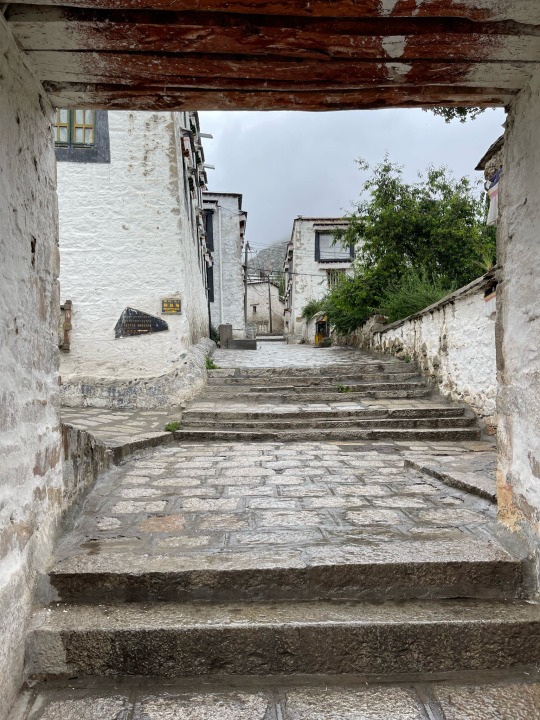
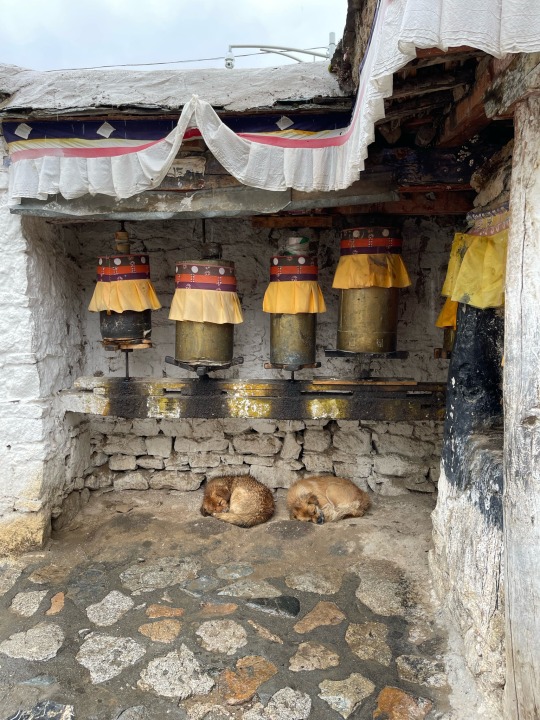
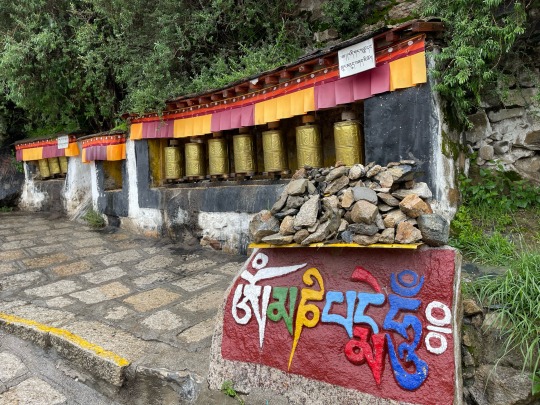
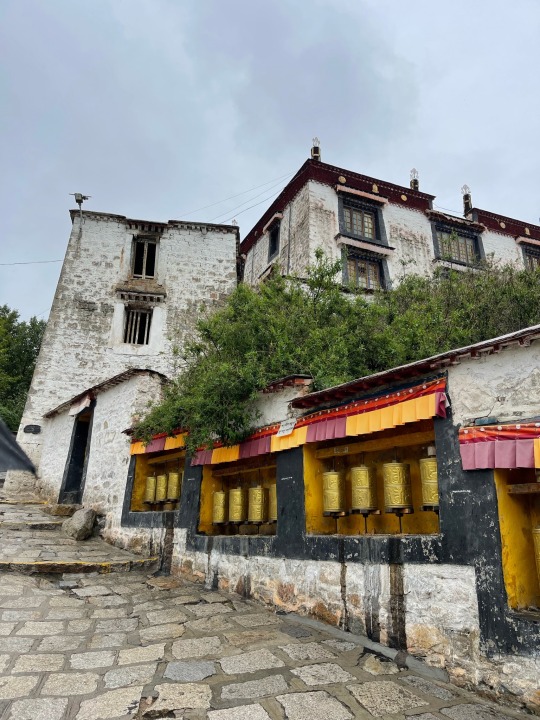

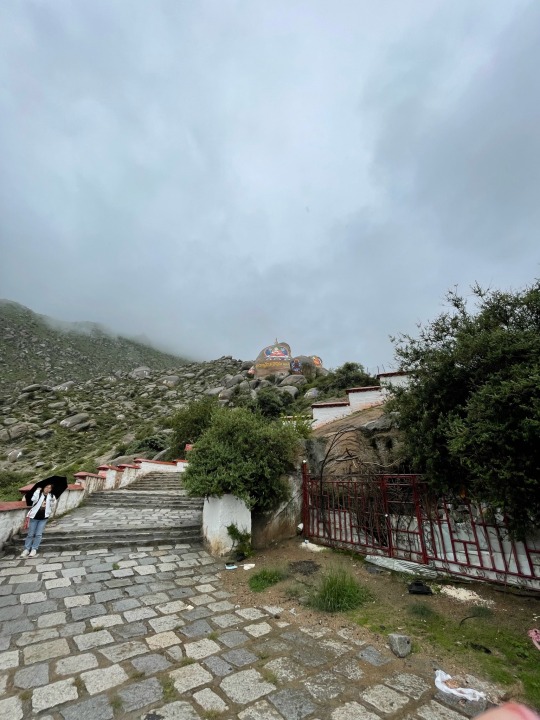

2 notes
·
View notes
Text

Unless you reflect on the truth of suffering to the point of actually becoming revolted by cyclic existence, your desire to attain liberation will be mere words, and whatever you do will lead to origins of further suffering.
~ Lama Tsongkhapa
���非你對痛苦的真相進行思維,以致於對輪轉的存在感到厭惡,否則你對獲得解脫的渴望將只是空談,無論你做什麼,都將是導致進一步痛苦的源頭。
~ 宗喀巴大師
0 notes
Text
The Life Story of Lama Tsongkhapa
Lama Tsongkhapa was a great yogi, practitioner, and a Mahasiddha.
(A Mahasiddha is an individual who, through the practice of yoga and tantra, attains the realization of siddhis, psychic and spiritual abilities, and powers). Born in Amdo, northeastern Tibet, Lama Tsongkhapa lived from 1357–1419, but the legacy of his life and teachings continues to this very day. The impact he has had on Tibetan Buddhism is vast and immeasurable, and it is because of Lama Tsongkhapa that we have many great teachings and seminal texts today.
The Birth of Lama Tsongkhapa
A great deal has been written about, and by, this remarkable teacher, whose birth was foretold by Buddha. In a past life, as a young boy, he offered Buddha Shakyamuni a crystal rosary and was gifted a conch shell in return. The Buddha predicted that the boy would be born in Tibet, establish a prominent monastery, present a crown to the Buddha statue in Lhasa, and play a key role in the spread of the teachings in Tibet. Everything unfolded exactly as the Buddha had foreseen.
The miraculous events surrounding his birth attracted the attention of the master Chöje Döndrup Rinchen, who had studied and lived in central Tibet before returning to Amdo, where he established two monasteries. When Tsongkhapa was three, this master presented livestock to Tsongkhapa’s father and requested that he be entrusted with the boy's education. At seven, Tsongkhapa moved to live with Chöje Döndrup Rinchen, who imparted many teachings and tantric empowerments to him. Tsongkhapa quickly mastered reading and writing, and from a young age, he devoted himself to both study and meditation practice. At eight, he received ordination as a novice monk and was given the name Losang Drakpa.
Lama Tsongkhapa’s Later Years
At the age of sixteen, Tsongkhapa left Amdo to pursue further studies, learning from around fifty teachers (some biographers suggest it could be as many as 100) and acquiring a comprehensive understanding of both sutra and tantra. He was particularly influenced by the reasoning systems of Dignaga and Dharmakirti.
At the age of thirty-three, Tsongkhapa met the extraordinary Lama Umapa, who had traveled to Tsang with the intention of studying under him. Umapa had experienced a vision of Manjushri, the embodiment of enlightened wisdom, which transformed his life from that of a simple cowherd. Inspired by this vision, he adopted practices related to Manjushri and eventually came to experience his constant presence.
Lama Umapa became Tsongkhapa's direct link to Manjushri. They spent time in retreat together, during which Umapa shared Manjushri's guidance and responses to questions about the proper understanding of reality. In time, Tsongkhapa himself began to have visions of Manjushri, who bestowed empowerments upon him and imparted teachings.
Traditionally, it is said that he accomplished four significant deeds during his lifetime: he renovated the Maitreya statue at Dzingji monastery and organized a grand prayer festival for its completion in 1400; he made extensive contributions to the vinaya, revitalizing the monastic tradition in Tibet; he established the annual Great Prayer Festival – Monlam Chenmo – which continues in Tibetan monasteries today; and he founded Ganden Monastery.
Tsongkhapa is perhaps best recognized for founding the Gelug tradition of Tibetan Buddhism, which is built upon the Kadampa tradition, the teachings of Atisha. The Gelug tradition, based on Tsongkhapa's insights, is characterized by the integration of sutra and tantra as well as a strong emphasis on vinaya. Having studied at Sakya, Kadam, and Drikung Kargyu monasteries, he emerged as a leading authority in Tibetan Buddhism.
Lama Tsongkhapa’s Books
In addition to his teaching, Tsongkhapa was a prolific author, producing eighteen volumes of collected teachings that include hundreds of titles. Among these, several texts are considered essential to Tibetan Buddhism, such as the foundational work on Guhyasamaja tantra.
Some of his most significant writings are:
- The Great Exposition of the Stages of the Path (Lam-rim Chenmo)
- The Great Exposition of Tantras (Ngag-rim Chenmo)
- The Essence of Eloquence on the Interpretive and Definitive Teachings
- The Praise of Relativity
- The Clear Exposition of the Five Stages of Guhyasamaja
- The Golden Rosary
These texts are vital resources for studying the Gelug tradition.
Lama Tsongkhapa & Lamrim
Why is the Lamrim important to Buddhism?
The Lamrim Chenmo stands as one of the most revered treasures in the vast collection of sacred literature worldwide. Authored by Lama Tsongkhapa, it was completed in 1402 and quickly became one of the most influential texts in Tibetan Buddhism, highly regarded for its spiritual depth and philosophical clarity. This work is particularly significant because it distills the vast teachings of the exoteric sūtras into a meditation manual that is easy to understand, making it a trusted reference for both scholars and practitioners alike. It is suitable for practitioners of all levels, as it provides a well-structured, step-by-step stages on the path to one’s enlightenment. The Lamrim serves as a comprehensive gateway to understanding the profound teachings of the Buddha.
Lama Tsongkhapa meticulously grounded his insights in the classical Indian Buddhist scriptures, supporting his explanations with quotes from these texts and the sayings of earlier masters from the Kadampa tradition. In this way the text demonstrates clearly how Tibetan Buddhism carefully preserved and developed the Indian Buddhist traditions.
Commemorating Ganden Ngamchoe
Lama Tsongkhapa Day, also known as Ganden Ngamchoe, is commemorated on the twenty-fifth day of the tenth month of the Tibetan calendar. It is a commemoration of Lama Tsongkhapa’s parinirvana. This is an annual grand event which many Gelug monasteries will offer thousands of lights for. Since Lama Tsongkhapa’s parinirvana, in 1419 on the 25th day of the 10th month, every year on this day, temples and monasteries hold memorial ceremony for him, which has continued for 600 years, without interruption.
Here are some of the prayers and practices of the Gelug tradition recommended for Lama Tsongkhapa Day to create merit: Lama Chopa, 1,000 Offerings to Lama Tsongkhapa, Extensive Offering Practice, The Glorious One of the Three Worlds (Päl dän sa sum ma), A Hymn of Experience, Destiny Fulfilled, Prayer for the Flourishing of Tsongkhapa’s Teachings, Lama Tsongkhapa’s Secret Biography, Dependent Arising: A Praise to the Buddha.
The most common prayer is the Five-Line Prayer to Lama Tsongkhapa (Mig-tse-ma):
MIG ME TSE WÄI TER CHHEN CHÄN RÄ ZIG
Avalokiteshvara, great treasure of non-objectifying compassion
DRI ME KHYEN PÄI WANG PO JAM PÄI YANG
Manjushri, master of stainless wisdom
DÜ PUNG MA LÜ JOM DZÄ SANG WÄI DAG
Vajrapani, destroyer of the entire host of maras
GANG CHÄN KHÄ PÄ TSUG GYÄN TSONG KHA PA
Tsongkhapa, crown jewel of the sages of the land of snow
LO ZANG DRAG PÄ ZHAB LA SÖL WA DEB
To Losang Dragpa, at your feet I make requests.
The recitation of the Migtsema prayer on Lama Tsongkhapa Day holds profound significance, as it is a way to honor the extraordinary qualities of Lama Tsongkhapa, a great scholar, meditator, and founder of the Gelug tradition of Tibetan Buddhism. The Migtsema prayer is a concise and powerful verse that praises Lama Tsongkhapa as the embodiment of wisdom, compassion, and spiritual power, manifesting as the union of Manjushri, Avalokiteshvara, and Vajrapani.
On this auspicious day, practitioners recite the Migtsema to cultivate devotion, accumulate merit, and strengthen their connection to Lama Tsongkhapa’s enlightened qualities. The prayer also inspires deeper faith in his teachings and the path he illuminated, encouraging practitioners to follow his example in study, practice, and realization. Reciting the Migtsema is believed to purify obstacles, generate wisdom, and create auspicious conditions for spiritual progress.
Conclusion
Lama Tsongkhapa Day marks the anniversary of the parinirvana of this important teacher who was born in the Amdo region of eastern Tibet and spent many years traveling from one monastery or yogic hermitage to another in search of the various lineages of the Buddhist teachings. Join us for prayers on 25/12/2024 (Wed), or offer lights, to commemorate Lama Tsongkhapa Day and pray for the flourishing and continuity of Buddhadharma! https://www.thekchencholing.org/blog/blogs-15/post/the-life-story-of-lama-tsongkhapa-220
0 notes
Text
Happy Lama Tsongkhapa (and also Xmas) if you celebrate
1 note
·
View note
Text

宗喀巴大师(1357~1419年),法名罗桑札巴,藏传佛教格鲁派创始人,“宗喀巴”乃后人之尊称。传说他为文殊菩萨转世,于元顺帝至正十七年(1357年,为藏历火鸡年)十月二十五日诞生在“宗喀”,故被称为宗喀巴。
宗大师的三大功德 :
一是严格地持戒,把戒律恢复到原始佛教那么严格;
二是学修按照次第,不能跳级,这样能够很快地得到成就;
最后一个,显密调和,显跟密的关系不是互相对立的,显教成就之后,就可以再上一步修密法了。
#tsem rinpoche#tibetan buddhism#buddhist#buddha#buddhism#Lama Tsongkhapa#Losang Drakpa#Big statue#Statue#Gelup#Practice#Vow
0 notes
Text


This special event was the inspiration that led us on to our most recent travels. - From India with Love ❤️ 🚀 Jet Setters 🚀
#travel#india#jetsetter#lifestyle#holiday#road trip#goa#south india#buddism#free tibet#dalai lama#je tsongkhapa#mahayana#tibetan buddhism#mundgod#karnataka#asia#south asia
2 notes
·
View notes
Text

Gaden Ngamchoe is the day of Lama Tsongkhapa's parinirvana, when he passed away and left his earthly body. This auspicious occasion falls on December 7, 2023 which is today.
Wish you all have a meaningful and positive lives from this auspicious occasion known as LAMA TSONGKHAPA DAY
(1357-1419)
6 notes
·
View notes
Text
Emptiness is the track on which the centered person moves.
Lama Je Tsongkhapa
28 notes
·
View notes
Photo

Beautiful Thangka painting painted in Nepal, Tsongkhapa. DM for inquiry! #luckythanka #thangka #thanka #art #painting #meditation #yoga #awareness #tsongkhapa #lama #mantramandala @mbsfestival @nantientemple @christiesparis @chenreziginstitute @21taras_big.love @tsemrinpoche @rubinmuseum @shop #bodhisattva #ommanipadmehum #rubinmuseum #tibet #tibetanart #handicraft #buddha #sydney #australia #singapore #malaysia #usa #uk #buddhism (at Lucky Thanka Art and Craft) https://www.instagram.com/p/ByHIoB3BL_3/?igshid=158d6drtwkavm
#luckythanka#thangka#thanka#art#painting#meditation#yoga#awareness#tsongkhapa#lama#mantramandala#bodhisattva#ommanipadmehum#rubinmuseum#tibet#tibetanart#handicraft#buddha#sydney#australia#singapore#malaysia#usa#uk#buddhism
1 note
·
View note
Note
thanks, and i hope not to be taking your time. i've read the buddhism is divided in three great traditions, namely theravada, mahayana and vajrayana. why were you drawn specifically to the last one? are there aspects of the other two that you enjoy? are there aspects of your tradition that you are critical of (and comfortable to publicly discuss)?
:D little biographical journey to flesh all this out for ya
yes buddhism is comprised primarily of three major organized schools! the study of buddhism divides them point blank, but theyre mostly divided by lineage and history!
but yeah i vibe diversely with each school because they focus on different things! im not about to give a descr of each school but...
my feelings on theravada when i explored it were that it emphasized discipline and quantifiability to a degree that i just couldnt realistically meet. i have a tendency for paralysis by analysis, so even on a good day any insight on a multi life path ends up falling flat in my practice. on the quantifiability front ive always disliked analytically breaking down rebirth ratios and fetter checklists. i dont like entering the stream or returning or escaping it all without developing bodhicitta. like, once i came in touch with bodhicitta it was fucking over.
ideologically speaking ive always been esoterically philosophical but somehow i found my way to the Mūlamadhyamakakārikā and its discursive lineage which kinda drove me away from theravada. those commentaries became too important to my practice for theravadan doctrinal conservatism to dismiss -- the institutions themselves hold true to the fundamental Pali Cannon as the only source for the path, potentially precluding a suffering being from developing wisdom and compassion from great mahayana texts such as the Heart Sutra. like cmon. i also have complaints about various partisan ethnonationalist fronts' equipment of theravadan institutional power. but read on to see just how unique that is.
lesson time: im actually not a vajrayana practitioner for two reasons. 1. my at this point refusal to receive empowerment for tantric practices and 2. my self isolation from any sangha! it was only recently that some lamas and gurus started transmitting lungs over zoom, after all. lineage, initiation, and yoga are what turns a middling sutra practice into higher tantra, but still they both diverge from theravada in that they emphasize emptiness, bodhicitta, and liberation in this life.
so the main distinction between mahayana and vajrayana ime (following tsongkhapa here) is that they play with emptiness differently. vajrayana is sometimes considered a swifter ticket on mahayanas greater vehicle of liberation in one life. the sutra path is a lifetime of study and employment of texts and teachers that mirror absolution, whereas esoteric or tantric paths actively employ them for greater potency and haste.
philosophy tangent the difference lies in the employment of madhyamaka critique. by problematizing the "two truths" our practice stutters and trips -- were forced to recognize that our formulations of the dharma are constrained to samsaras playing field. how far can text and teachings get us when its discernment reinforces our reliance on, for example, the stability of effective communication? or our attachment to text as an object, rather than a true integration? tantra steps past that. by directly communing with a root guru, training in highest yoga tantra offers immediate liberation.
a distinction at play here is one of the main reasons i didnt connect with theravada -- quantifiably measuring rebirth and enlightenment progress. you see, the stability of vajrayana doctrine rests in its institutional enforcement through tulkus. these lineages represent a few things. first, our capacity to come back and keep teaching. second, our ability to parse bodhicitta in this life. and third, our opportunity to commune with dharma in the flesh.
now, the doctrine backs it up, it makes sense and all that, but id like to see a successful, truly liberated tulku for once. one who sees samsara in imperialism and borders, in sexual and gendered forms of domination, in the sanctity of our peaceful sanghas isolated from the unrest outside.
you look me in the eyes and tell me that the myriad lamas who rape, abuse, extort, and control their sangha are enlightened. i dont trust these mfs. and frankly it makes the whole process of lineage reincarnation seem fishy to me.
what it ends up being, in my opinion, is a consolidation of social power in religious institutions. and the recognition of reincarnated masters - my god its all a politics game. tulku heads of state, religious nationalism, theres no absolution there! these are structures upon structures which conceal rampant abuse, opportunistic political alliances, embezzlement, and other exploitative measures that dharma aristocracy dabbles in!
im super anti institutionalized religion, to the point where im constantly interrogating my willingness to engage with buddhism! at what point do spiritual structures stop facilitating the path and start reviving the adversity! if we can recognize that certain vehicles are going to be hindered by karma, why do we act as if any individual is an infallible conduit of the dharma!
phew. didnt realize i wanted to rant today
4 notes
·
View notes
Text
With my heart going out with great compassionIn whatever direction the most precious teachingsHave not yet spread, or once spread have declined,May I reveal this treasure of happiness and aid.
- Lama Tsongkhapa
2 notes
·
View notes